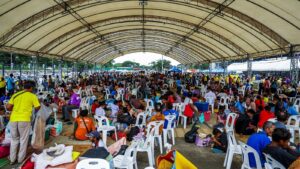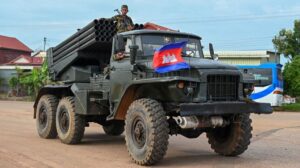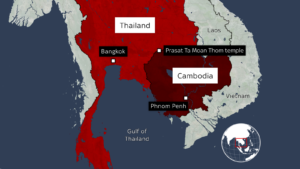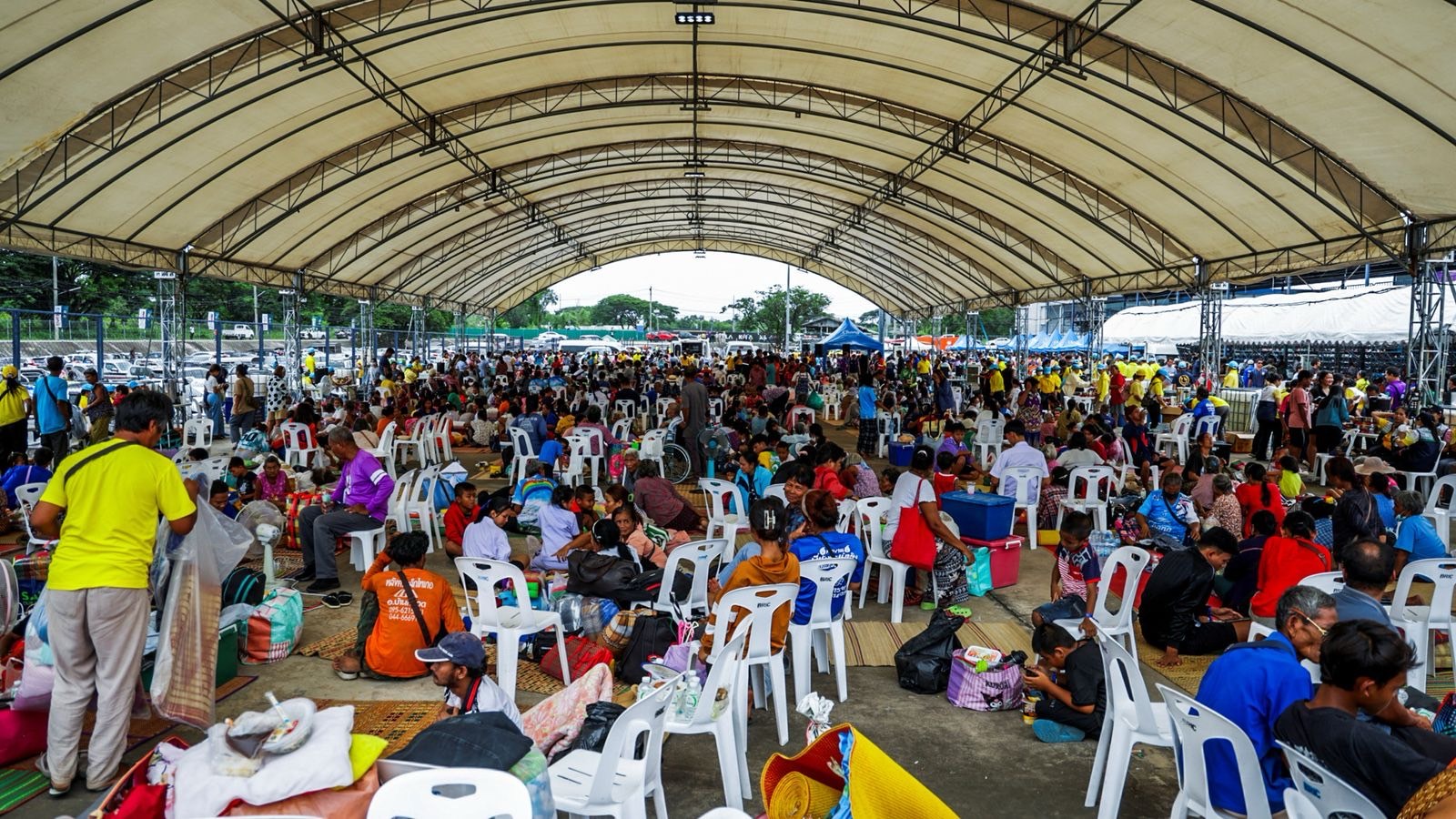
(Displaced Thai civilians gathered up awaiting help and relocation. / Source: Reuters)
Warta Kema – A dispute at the border between Thailand and Cambodia turned deadly last Thursday (24/07). The armed conflict happened in an area near the Prasat Ta Moan Thom temple in Thailand’s Surin province, right across Cambodia’s Oddar Meanchey region. As of Monday, July 28th, Sky News has reported that the death toll reached 35 people, including an estimated 13 Thai and 8 Cambodian civilians. The conflict also led to the displacement of over 260.000 residents around the border.
The chronology of the event was reported differently from both sides. Cambodia stated that the dispute started because Thailand launched airstrikes against the Cambodian military along the border. Cambodia has also accused Thailand of violating arrangements of not deploying troops near the Ta Muan Thom temple. On the other hand, Thailand mentioned that Cambodia launched military raids towards civilian groups located near the border, resulting in a few casualties.

(Cambodian military truck deployed around the border after the strike. / Source: BBC)
The confirmed timeline of the dispute, according to CNN, happened after a Thai soldier lost a leg after stepping on a landmine the day before (23/07). Thai jets dropped bombs on Cambodian military targets soon after, with Cambodia confirming that there was an F-16 jet deployed to drop bombs near the Preah Vihear temple. This event soon prompted a full armed clash between the two sides.
Relations between Thailand and Cambodia have been relatively tense since the time when Cambodia was still under French rule. The issue between the two countries mainly revolves around a territorial dispute for the 817-kilometre-long border across the regions of Surin, Sisaket and Ubon Ratchathani. This existing tension escalated massively in 2008, when Cambodia tried to register a temple in those regions as a UNESCO World Heritage Site. Over the years, there have been multiple clashes between the borders of the two, with the most recent being in May when a dispute eventually killed a Cambodian soldier.

(Depiction of the regions of Thailand and Cambodia, with the disputes pictured around the borders near Ta Moan Thom temple. / Source: Sky News)
A professor from the Department of International Relations at Universitas Padjadjaran, Teuku Rezasyah, mentioned that the escalation of the border issue is due to the incapacity of the two countries to supervise the borders well enough to ensure there is no conflict. “The root causes are lack of governance from both countries and the inability of the two countries to deal with the border issues (such as) narcotics there and transnational crime,” he mentioned.
He then added that the internal issues both countries are currently facing, and the usage of the French map as a reference point for territory, even today, contributes to the heightened tensions.
“They (the current leaders of the two countries) are the legitimate governments, the legitimate leaders, but if we try to check they have problems inside, and (another factor is) the map itself (that) was made by the French colonials years ago,” he explained.
Both Thailand and Cambodia have been facing major internal problems for the past few years. On one hand, Thailand has been facing political instability due to surrounding controversy regarding the fragile coalition of current prime minister Paetongtarn Shinawatra and economic downfall caused by increasing tariffs and questionable budget for the next fiscal year. On the other, Cambodia has been controlled by the Hun family’s unstable political regime for the past forty years. Crime rates and human rights violation cases in Cambodia have also been at an all-time high. The problems both parties face can be considered a driving factor to hostile behaviour, in addition to the already long-standing rivalry between Phnom Penh and Bangkok.
Currently, a temporary ceasefire has been put in place as a result of Malaysia’s mediation efforts ahead of ASEAN’s anniversary on August 8th. However, aftermaths of the dispute are still being put into play by both countries as Thailand is now putting tighter restrictions on crossing the border and Cambodia is banning all Thai media from being aired nationwide, as well as halting Thai imports of fuel, fruits and vegetables.
When asked about how neighbouring countries may contribute to the length of the ceasefire, Teuku mentioned that those in ASEAN should emphasise the value of unity between members.
“What they (Thailand and Cambodia) could do is to make sure that they are both stable, to better control their borders so they are not involved. At the same time, highlight the spirit of ASEAN: Non-intervention. Highlight the enmity of cooperation. Highlight the principles of the ASEAN Charter and highlight the zone of peace, freedom and neutrality. Make themselves strong, stable and not to be easily affected by outsiders (non-governmental groups).”
Within Thailand and Cambodia, Teuku advised that in order to minimise the disputes between them, some concrete actions both governments can take are to have discussions regarding the locations of the temples, have them fixed in one territory, but allow special treatment for religious folk from the other country to access it easily.
“The location of the temples are in Cambodia but there is also a need to give special treatment to the Thai religious observers to come. Make it (the territory) internationally controlled, there should be a demilitarised zone and there should be spots to permit the United Nations Peacekeeping Forces to be there,” he explained.
The issue can also be solved by tackling the debate regarding the highly controversial French map and allowing clarity.
“If the Thai authorities can show the minutes (time of the map-making), if the Cambodian can show the minutes and if the French are ready to show the minutes then we can revise the map democratically, accepted by both. And also to be done under the UN supervision.”
In regards to the United Nations, Teuku also hopes that the implications of the current conflict will drive the council to restructure and evaluate in order to take better action in negotiating peace.
“Well potentially, similar issues could come (from) anywhere. At the moment (there are) issues in Europe, there are issues in the Middle East and now it comes to Southeast Asia. So we are witnessing multiple kinds of critical issues, and then less capability of the UN to deal (them) at the same time. So in my mind, in order to better deal with this we need to restructure the UN,” he explained.
“The UN has been there since October 1945. It was based on the winners and the losers of the Second World War. Now, we are far away from that situation; we need to restructure the UN because at the moment not every civilisation is represented,” he added.
He concluded that the United Nations and its members need to think about the qualities of the peace-loving nations in this world. It should be reformed so that more nations can voice out their aspirations and not be easily vetoed in the Security Council.
Reporter: Andrea Hillary Gusandi
Editor: Syafina Ristia Putri

